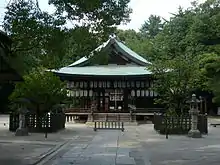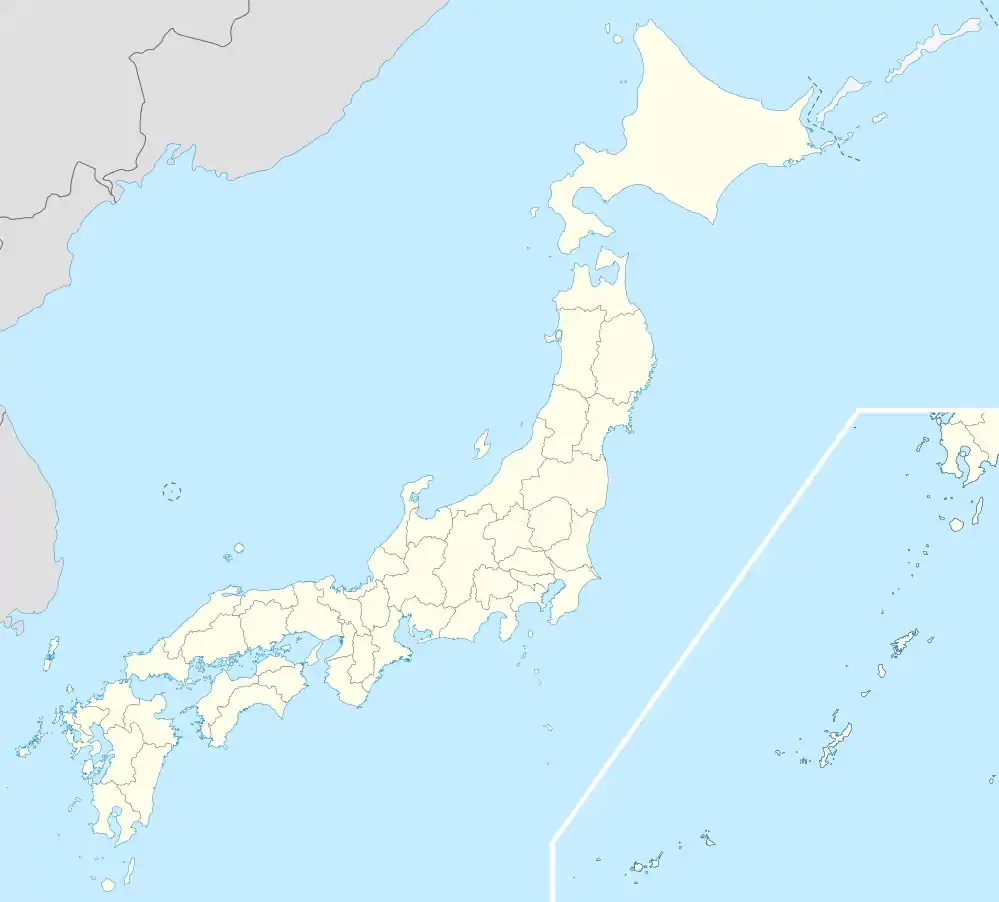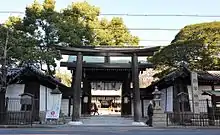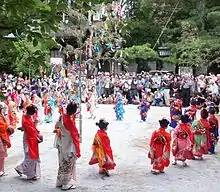Shiramine Shrine
Shiramine Shrine (白峯神宮, Shiramine jingū) is a Shinto Shrine in Kamigyō-ku, Kyoto[1]
| Shiramine Shrine 白峯神宮 | |
|---|---|
 The haiden of Shiramine-jingū, Kamigyō, | |
| Religion | |
| Affiliation | Shinto |
| Deity | Emperor Junnin, Emperor Sutoku |
| Type | Imperial Shrine |
| Location | |
 Shown within Japan | |
| Geographic coordinates | 35.0303°N 135.753°E |
The Shrine is dedicated to the veneration of the kami of Emperor Junnin[1] and Emperor Sutoku. Annually in mid–September two Noh performances are held at the Shiramine Shrine in memory of Emperor Sutoku.[2]
Shiramine is also home to the deity Seidai Myojin who is popularly known as the god of sports, and especially soccer.[3]

The lucky charm(叶う輪 Kanauwa) of Shiramine Shrine is very popular to worshipers. Kanauwa is Lucky charm of sports.


Kanpei-sha
In 1871, the Kanpei-sha (官幣社) identified the hierarchy of government-supported shrines most closely associated with the Imperial family.[4] The kampeisha were shrines venerated by the imperial family. This category encompasses those sanctuaries enshrining emperors, imperial family members, or meritorious retainers of the Imperial family.[5] Up through 1940, the mid-range of Imperial shrines or Kanpei-chūsha (官幣中社) included the shrine; and it was then known as Shiramine-gū[6] In 1940, Shiramine's status was changed to Kanpei-taisha (官幣大社), which is the highest rank; and since then, it has been known as Shiramine jingū.[7]
Festivals
Shunki Reitaisai Festival
(Grand Festival of Spring)
April 14
Kemari 10:30 a.m.
Budō(武道)shoureisai
(Festival of Budō(武道))
May 5
Japanese Budō Demonstration from9:00 a.m.(all day long)
Seidaimyoujin Reisai Festival
July 7
Kemari 2:00 p.m.
Komachi-odori 4:30 p.m.
Notes
- Ponsonby-Fane, Richard. (1959). The Imperial House of Japan, p. 126.
- Kerr, Amy. "Noh Plays at Shiramine Shrine." September 2008.
- "Japan shrine keeps ancient soccer alive and kicking," Reuters. July 17, 2007.
- Ponsonby-Fane, Richard. (1959). The Imperial House of Japan, p. 124.
- Institute for Japanese Culture and Classics, Kokugakuin University: Glossary of Shinto Names and Terms, Kampei Taisha.
- Ponsonby-Fane. Imperial, p. 125.
- Ponsonby-Fane, Richard. (1963). The Vicissitudes of Shinto, p. 394.
References
- Ponsonby-Fane, Richard Arthur Brabazon. (1959). The Imperial House of Japan. Kyoto: Ponsonby Memorial Society. OCLC 194887
- _______________. (1962). Studies in Shinto and Shrines. Kyoto: Ponsonby Memorial Society. OCLC 399449
- _______________. (1963). The Vicissitudes of Shinto. Kyoto: Ponsonby Memorial Society. OCLC 186605327